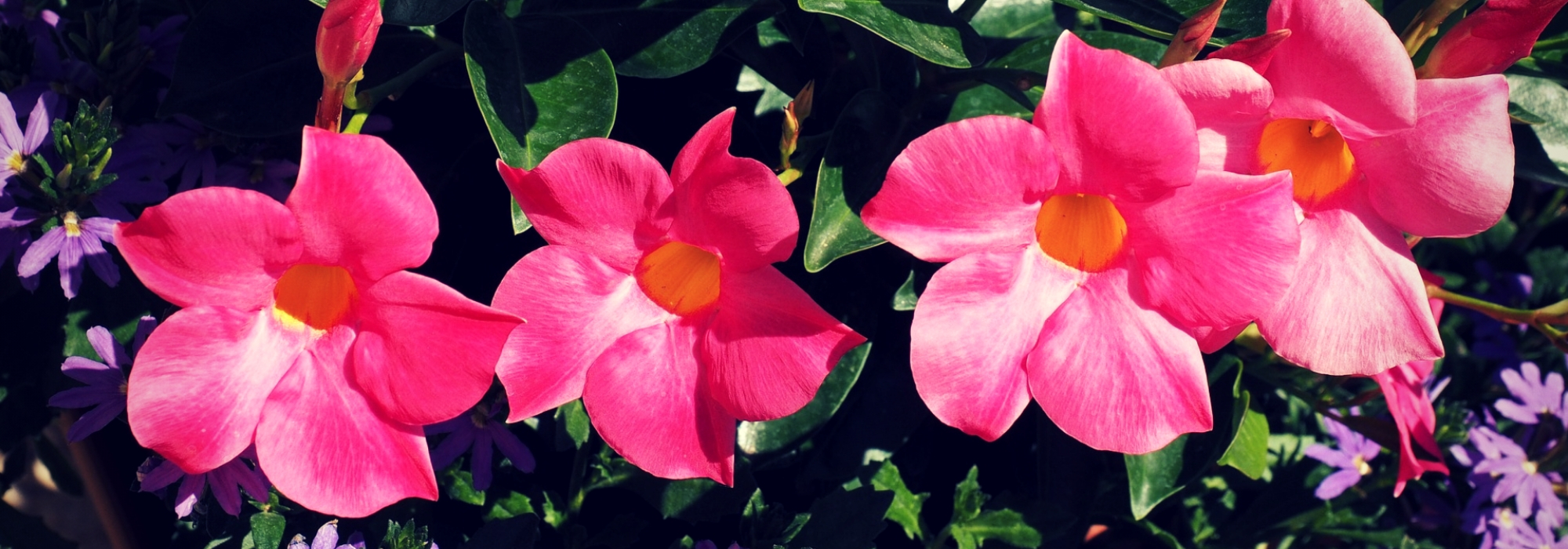
Dipladenia, Mandevilla: planting and care
Contents
Dipladenia in a nutshell
- A lovely climbing voluble and very floriferous plant that tirelessly produces beautiful star-shaped flowers until the frosts
- Fast-growing, heat-resistant, and low in water requirements, it is truly easy for amateur gardeners to succeed with, thriving in full sun in well-drained ordinary soil
- It offers vibrant colours of pink, red, white, or yellow set against a backdrop of glossy dark green leaves
- Frost-sensitive, it is grown as an annual and should be reserved for open ground in mild climates
- Magnificent and versatile, it adapts to all your desires: in a pot, a bowl on the balcony or terrace, or even in open ground to cover a trellis or arch or to border a rockery
A word from our expert
The Dipladenia or mandevilla is a remarkable climbing voluble plant that is highly floriferous, forming a true bush of glossy leaves covered in star-shaped flowers in pink, white, or red, continuously until the first frosts.
With its bright colours that combat gloom, it is the ideal summer plant: it blooms tirelessly, barely affected by drought, and always adds a bright and exotic touch to the garden or terrace.
Among the series derived from Mandevilla sanderi, “Sundaville” with pink or red flowers, the “Rio” dipladenia, and the Diamantina collection, which includes the first variety of white Dipladenia ‘Jade White’, are the most popular.
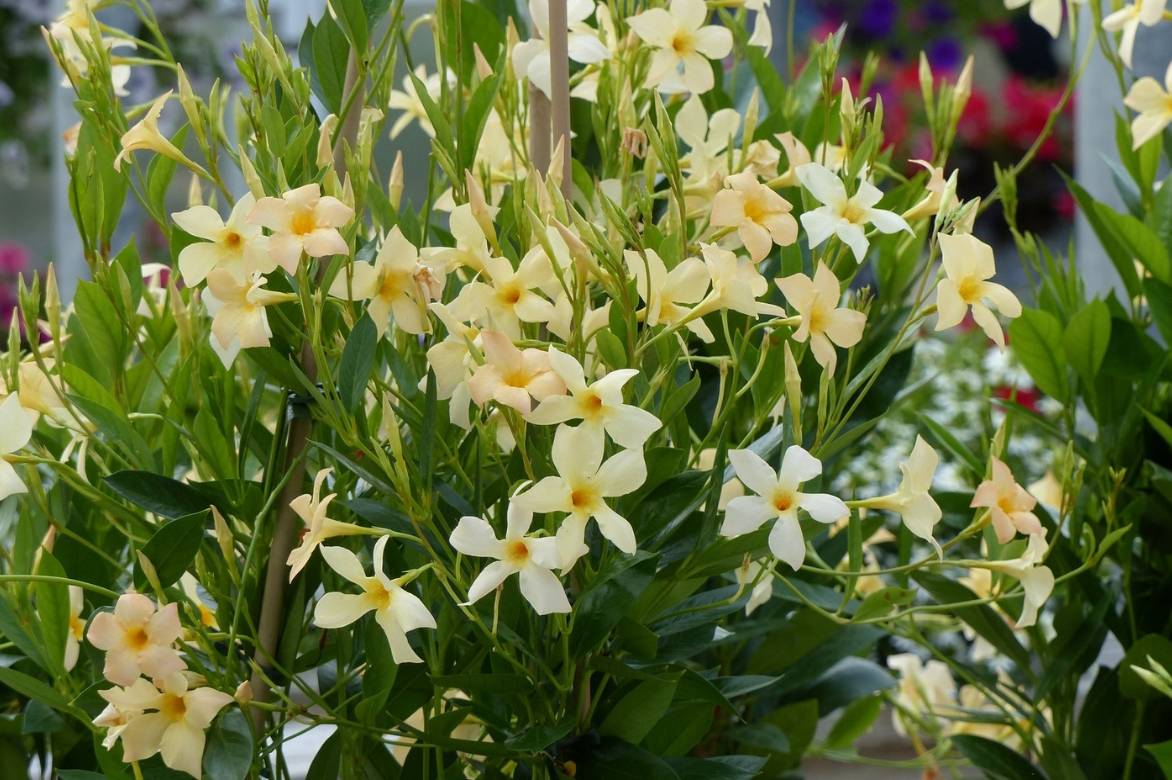
Dipladenia ‘Sundaville Mini Yellow’ with bright pale yellow star-shaped flowers
If this lovely small non-hardy liana is reserved for mild climates, in other regions, it is often grown as an annual or in pots that should be brought indoors in winter: it will easily survive the harsh season in a bright conservatory or a lightly heated greenhouse.
Easy to grow in full sun, in any humus-bearing, light soil, fresh to occasionally dry, it will thrive in pots, window boxes, or bowls on terraces or even in the ground to flower borders, pergolas, or trellises.
Discover our selection of dipladenia colours and fall for these essential summer flowers to bring cheerfulness and colour!
Description and Botany
Botanical data
- Latin name Mandevilla
- Family Apocynaceae
- Common name Dipladenia
- Flowering From May-June to October
- Height 0.40 to 7 m
- Exposure Sun, partial shade
- Soil type All, well-drained
- Hardiness not hardy
Originating from the tropical wooded areas of South America, notably Brazil and Central America, the Dipladenia, now called Mandevilla in honour of the diplomat and gardener Henry Mandeville, belongs to the Apocynaceae family, just like the oleander.
This non-hardy tropical perennial is often grown as an annual in our climates or in pots to be stored over winter.
The genus Mandevilla comprises around 120 climbing species, some of which have been the subject of extensive hybridization programmes. It is the Mandevilla sanderi or Brazilian jasmine that has given rise to numerous hybrids and particularly floriferous varieties, more compact, with varied habits and colours. The ‘Sundaville’, ‘Rio’ series and horticultural hybrids selected for their compact habit, well-suited for pot cultivation, exceptional flowering, and unique colours such as the yellow ‘Opale Citrine’ (the first yellow dipladenia!) from the new ‘Diamantina®’ range, are the most well-known.
The Dipladenia has a bushy, slightly trailing habit, more or less branched and sometimes decidedly climbing (Mandevilla x amabilis ‘Alice du Pont’). It comes in compact, semi-climbing or climbing varieties.
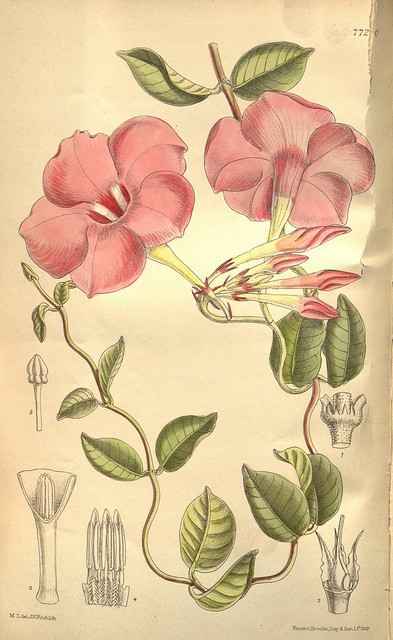
Dipladenia eximia – botanical illustration
Of rapid growth, it develops from fleshy tuberous roots, short, flexible, woody stems at the base containing a white latex (toxic if ingested and irritating to the touch), which wrap around any support reaching heights of up to 6-7 metres. The climbing branches emit aerial roots that allow the plant to cling to any support, somewhat like ivy. The compact varieties will not exceed on average 40 to 85 cm in all directions.
These climbing stems form a tangle of fine, thin branches bearing a persistent foliage that is both lush, light, and leathery.
It consists of small entire leaves with marked lamina ending in short points, oval to elliptical in shape. Arranged oppositely, they measure 5 to 20 cm long and are a medium to dark glossy green.
This shiny foliage serves as a backdrop to the generous and long-lasting flowering. Remarkably long, it lasts for at least 6 months, from spring, sometimes as early as May, to autumn.
This small climbing plant charms with its large trumpet-shaped flowers that are widely open or in narrow funnels, which bloom continuously until the first frosts. Gathered in axillary clusters of 3 to 20 flowers, they measure 5 to 10 cm in diameter and are shaped with 5 wide, spreading lobes, rounded or slightly pointed that slightly overlap.
These large star-shaped flowers often take on vivid hues imbued with dynamism. From bright pink to salmon pink, to velvety scarlet red through to immaculate white or golden yellow, centred on a yellow throat, the corollas are sometimes veined darker. Some mandevillas (M. boliviensis) have fragrant flowers.
The dipladenia or mandevilla is a frost-sensitive perennial, rarely tolerating temperatures below -5°C. It is not grown in the ground in beds or borders, to dress a pergola or trellis except in regions spared by frost, from the south of the Atlantic coast to the Mediterranean coast.
Elsewhere, in colder regions, it will be grown as an annual on the terrace or balcony in pots, hanging baskets or bowls to be stored over winter in a conservatory or garden to be renewed each spring.
While it enjoys warm, sunny exposures, it will appreciate light shade during the hottest hours of the day. It thrives rapidly in any type of light, well-drained soil.

Some flowers of Dipladenia: D. Diamantina Jade Scarlet, D. Diamantina Jade Pink and D. Diamantina Jade White
Main species and varieties
Dipladenia have been the subject of an extensive hybridization programme. Mandevilla sanderi has given rise to numerous hybrids and varieties that compete for splendour, the length of their flowering and their varied colours. Among them is the Diamantina® series, which offers compact Dipladenia, particularly well suited for pot cultivation and appreciated for their exceptional floribundity and unusual colours such as the immaculate white of Mandevilla Diamantina ‘Jade White’ or the golden yellow of ‘Opale Citrine’.
The most popular
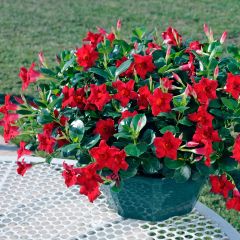
Dipladenia Diamantina Jade Scarlet
- Flowering time June to October
- Height at maturity 85 cm
Our favourites
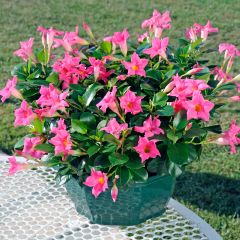
Dipladenia Diamantina Jade Pink - Mandevilla
- Flowering time June to October
- Height at maturity 40 cm
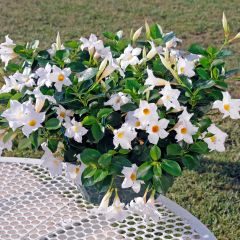
Dipladenia Diamantina Jade White
- Flowering time June to October
- Height at maturity 40 cm
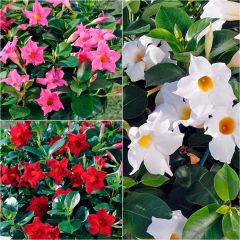
Collection of 3 Dipladenia Diamantina Jade
- Flowering time June to November
- Height at maturity 40 cm
Discover other Dipladenia
View all →Available in 1 sizes
Available in 0 sizes
Available in 2 sizes
Available in 1 sizes
Available in 2 sizes
Available in 1 sizes
Available in 1 sizes
Available in 1 sizes
Available in 1 sizes
Available in 1 sizes
Planting dipladenia or mandevilla
Where to plant dipladenia?
From its tropical origins, dipladenia has retained a high sensitivity to cold. It cannot withstand temperatures below -5 °C and can die at 0 °C. This is why, even though it flowers until frost, it is often grown as an annual in our climates or in pots that need to be stored indoors during winter, in a conservatory or greenhouse (where it requires a minimum of 10 to 15 °C), as soon as temperatures drop below 12 °C. You can bring them out on sunny days as soon as temperatures rise above 15 °C and frost is no longer a concern.
On the other hand, it is easy to grow in the ground in regions of southern France that are completely spared from frost, provided it is placed in a well-sunny spot and sheltered from the wind.
In the garden, dipladenia will appreciate a light, well-drained soil, without excess lime that would cause the foliage to yellow. Its flowers will enjoy a light shade for a few hours a day in summer.
Soil that is too rich would encourage foliage production at the expense of flowering.
To thrive, this non-hardy perennial only requires sunlight and warmth along with some watering: like all tropical plants, it enjoys humid environments and will be particularly comfortable in a greenhouse or conservatory with light but without direct sunlight.
However, it will be quite resistant to summer drought and will easily tolerate missed waterings, which is ideal for use in pots or containers.
On the other hand, its roots will not tolerate excess water that will cause them to rot.
In cold regions, dipladenia is often used to flower terraces, balconies, or patios, either alone or mixed with other annuals. It is best placed in a large flowering pot or container exposed to full sun.
In pots or in the ground, its vines will climb on any support (pergolas, wire fences, trellises, arches), and it can be leaned against a wall, climbing up to the tops of small trees. When trained, it can grow over 6 m high over time.
If left untrained, it will form a small flowering bush all summer in a sunny rockery.
Its foliage is evergreen: a significant advantage when you want to edge the border of a staircase or crown a slope.
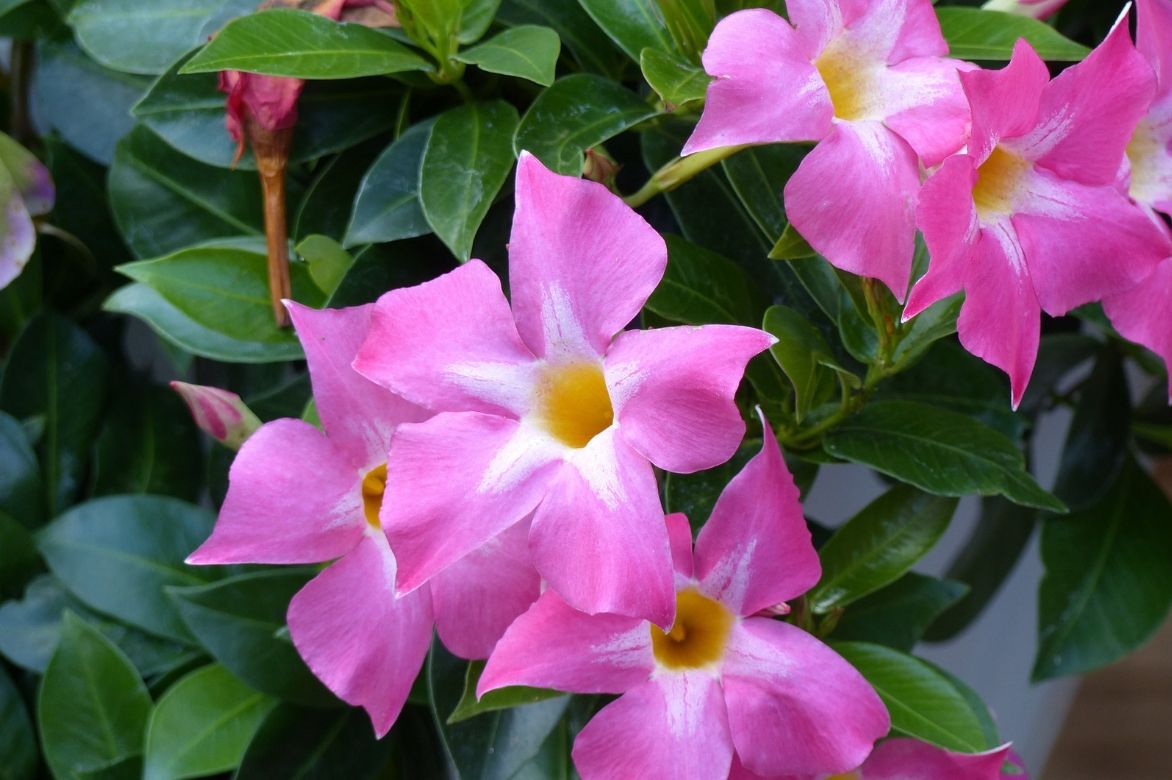
Dipladenia ‘Bella Pink Star’
When to plant dipladenia?
In the ground, plant dipladenia in April-May after the last frosts. This plant does not withstand negative temperatures: planting is possible under cover from March onwards.
How to plant dipladenia or mandevilla?
In the ground
Maintain a planting distance of 1.5 to 2 m, given its rapid growth, this will be sufficient to create a beautiful effect. Plant in a soil lightened with potting soil and coarse sand. If necessary, provide a support for it to climb. Choose from our young dipladenia plants in plug plants: upon receipt, transplant and store them under cover for a few weeks before placing them outside as soon as the risk of frost is definitely over.
- Dig a hole two to three times wider than the root ball
- Spread a layer of gravel or clay balls for good drainage and to avoid stagnant moisture at the roots
- Do not bury the plug plant too deeply (1 cm below the soil surface)
- Be careful not to break its stems during planting
- Mix well-decomposed compost with the extracted soil and backfill
- Lightly compact and water generously
Planting dipladenia in a pot
The dipladenia is particularly vigorous in pots, making it the ideal plant to grow in window boxes, containers, or pots. The substrate must be very draining to avoid stagnant moisture at the roots.
- In a large pot, spread a good layer of drainage (gravel or clay balls)
- Plant in a well-draining mix of geranium potting soil and sand
- Attach the stems to the support
- Water at planting and then moderately every three to four days during flowering, allowing to dry between waterings
- Store the pot in autumn sheltered from the cold but in light, in a conservatory or a temperate greenhouse at about 10-15 °C
- Bring your pot out in May as soon as the outside temperature is mild, avoiding too much scorching sun
→ More information in our advice sheet: How to grow dipladenia in a pot?
Read also
Planting annualsHow to care for a Dipladenia?
In Open Ground
The dipladenia does not tolerate excess water. It requires little watering and can even withstand short periods of drought. Water moderately with non-limestone water.
In regions with mild winters, protect the aerial parts of the plant with a winter cover.
In colder regions where dipladenia is grown as an annual, in autumn, pull up the clumps.
→ To learn how to prune a dipladenia, check out our tips in Christine’s tutorial.
In Pots
At the start, help its stems to climb.
In pots, a more regular watering is necessary, as well as a liquid fertiliser for flowering plants twice a month.
In summer, water with non-limestone water, once or twice a week as soon as the soil is dry, but without excess. In winter, water only every eight to twelve days, allowing the soil to dry out well between waterings and stop fertilising.
Repot every 1 to 2 years, preferably in spring, and in any case outside of the flowering period. Learn more in our tutorial When and how to repot a Dipladenia?
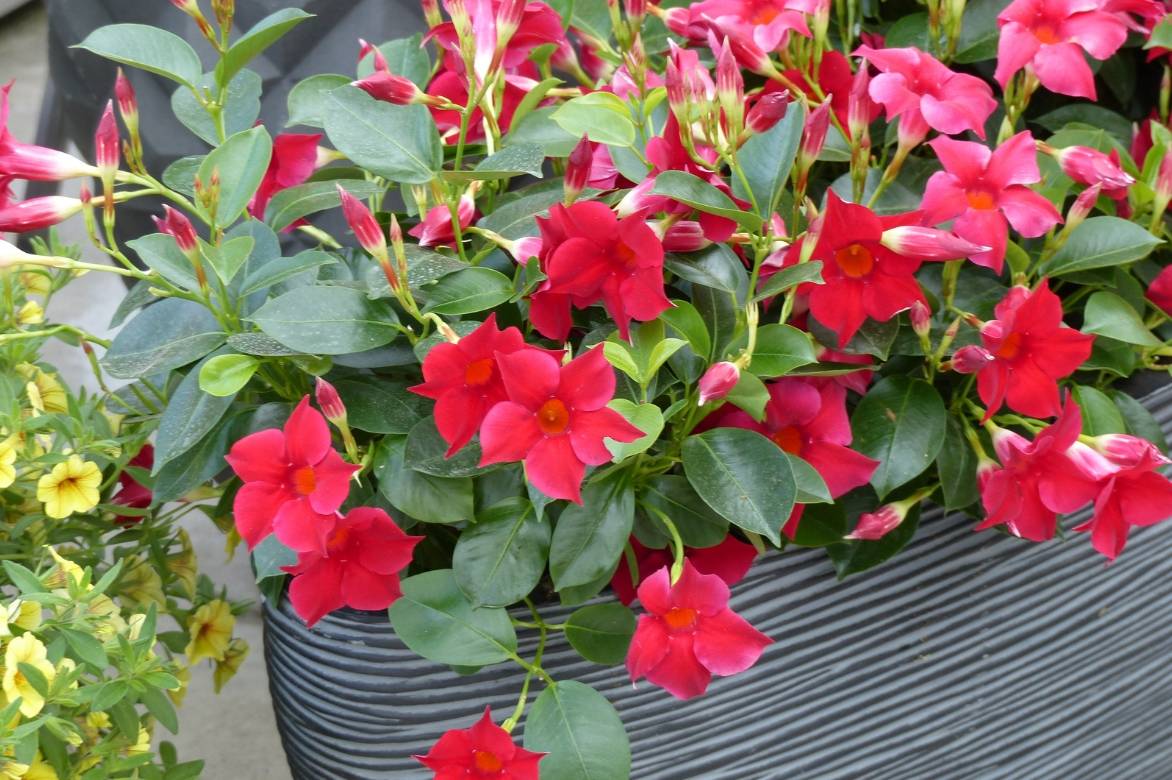
The Dipladenia creates beautiful flowering planters all summer long
How to Prune a Dipladenia
Although not necessary, pruning is recommended and should be limited each year after each flowering to maintain a compact shape and remove weak, damaged stems. It does not mind being refreshed regularly, which will keep it bushy and dense with generous flowering.
- Remove faded flowers to encourage the appearance of new ones
- At the beginning of spring, in February-March, wearing gloves, pinch the tips of the green stems to stimulate flowering
- On a Dipladenia over 3 years old, prune each year, always at the very beginning of spring, at the time of sap rising, the stems to 3 or 4 buds from the main stem
Read this to keep your plants in cold climates: The Dipladenia in winter: protecting it from the cold
And listen to our podcast to find out how to winter your dipladenia:
Diseases and potential pests
Red spider mites thrive in a warm and dry atmosphere: to get rid of them, regularly spray non-limestone water on the foliage to maintain a humid environment around the pot.
Plants grown in open ground are sometimes victims of aphids. Spray non-limestone water mixed with black soap or Marseille soap.
If the leaves of the dipladenia turn yellow, it is likely due to overwatering. When repotting, use a well-draining potting mix (add sand) and do not let water stagnate in the saucers under the pots.
How to take cuttings of Dipladenia or Mandevilla?
The Dipladenia is propagated by herbaceous cuttings in May or semi-woody cuttings in August. The process is quite tedious as it is done in a humid mini-greenhouse, using plant hormones and bottom heat. To renew your plants, we recommend instead our Dipladenia plug plants.
To propagate Dipladenia:
- take heel cuttings of about 8 cm to 10 cm from secondary shoots
- remove the lower leaves, keeping those at the top of the stem
- dip the base of the cuttings in rooting hormone
- plant them in pots in a light, well-draining substrate of sand and turf
- place in a humid environment at a temperature of 18 °C in a mini-greenhouse or cover with plastic
- transplant outdoors in the following spring after the frosts
→ Learn more about propagating Dipladenia in our tutorial!
Associating
The Dipladenia ensures a very floral spring and summer. Lush, with its star-shaped flowers in vibrant colours, it thrives in various styles of gardens. It will adorn any support provided with a dynamic or delicate touch.
It is most often found in a pink garden, in fresh and romantic white/pink associations with roses and other beautiful climbing plants, but also in all vivid colour compositions to brighten up your space!
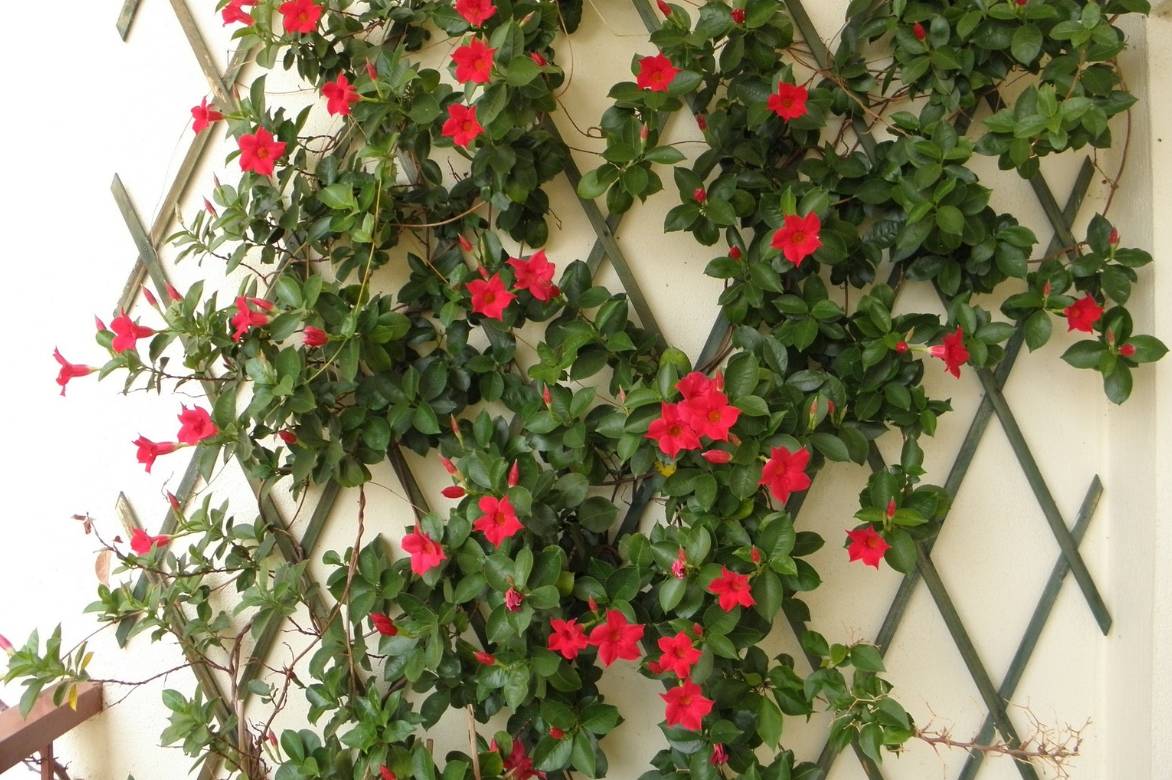
A Dipladenia grown against a wall in a mild climate
In gardens with a mild climate, it can be grown against a wall where it will bloom abundantly, entwining small trees alongside other frost-sensitive climbing plants such as passionflowers, black-eyed Susans, Sollya Heterophylla, Hardenbergia Violacea, or a Plumbago capensis.
They pair perfectly with each other; mix Mandevilla varieties together to create floral and tangy compositions.
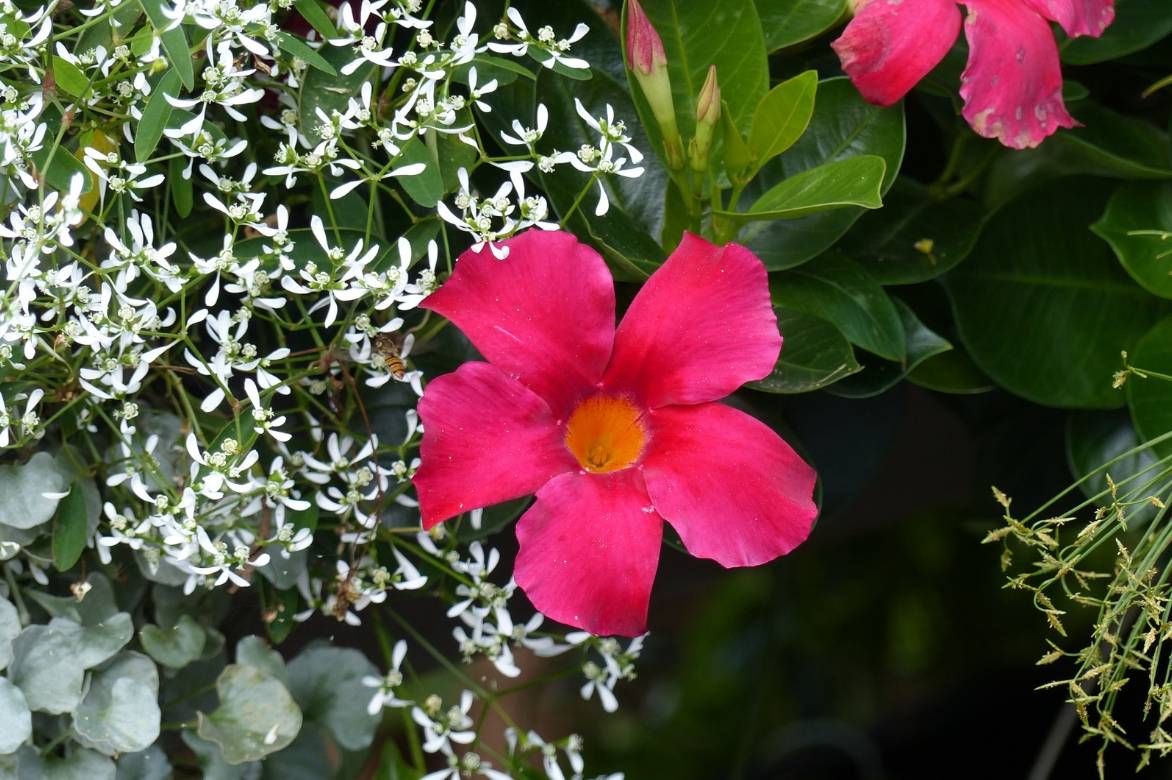
An example of a pot association: Dipladenia, Euphorbia ‘Diamond Frost’, and Dichondra ‘Silver Falls’
In large pots, create a contrast with other annuals such as the trendy ‘Night Sky’ varieties of Petunias, lobelias, and begonias.
You can also plant it in borders, to punctuate borders of Agapanthus or form a flowering bush at the foot of Agératum in pink or white colours or with annual poppies in pastel shades.
Useful resources
- Potted plants and watering: managing the heat during your absence
- Discover our ideas to combine Dipladenia
- Check out our article to identify and treat diseases and pests of Dipladenia
- Fall for our climbing plants for pots
- Follow all our tips on annual plants live from our blog!
- A trendy happy garden? Yes, with our Dipladenia!
- 10 tips for successfully growing Dipladenia
- How to grow Dipladenia in pots?
- Dipladenia: our sure values for a flowering garden all summer long.
Frequently asked questions
-
Where to place Dipladenia during winter?
Dipladenia are generous but tender plants, most often grown as annuals. If you wish to keep them, they will easily survive the winter behind a glass door, in a bright conservatory, or in a lightly heated greenhouse at 10-15°C. Place them out of direct sunlight and drafts, and bring them back outside as soon as temperatures exceed 15°C. They will then accompany you for many years.
-
Why are the leaves of my Dipladenia turning yellow?
This is likely due to a cold snap or excess water. Ensure it is protected from drafts and that the substrate is well-draining, even slightly sandy. Never allow standing water in the saucers under the pots and, if possible, only water with non-calcareous water.
- Subscribe!
- Contents
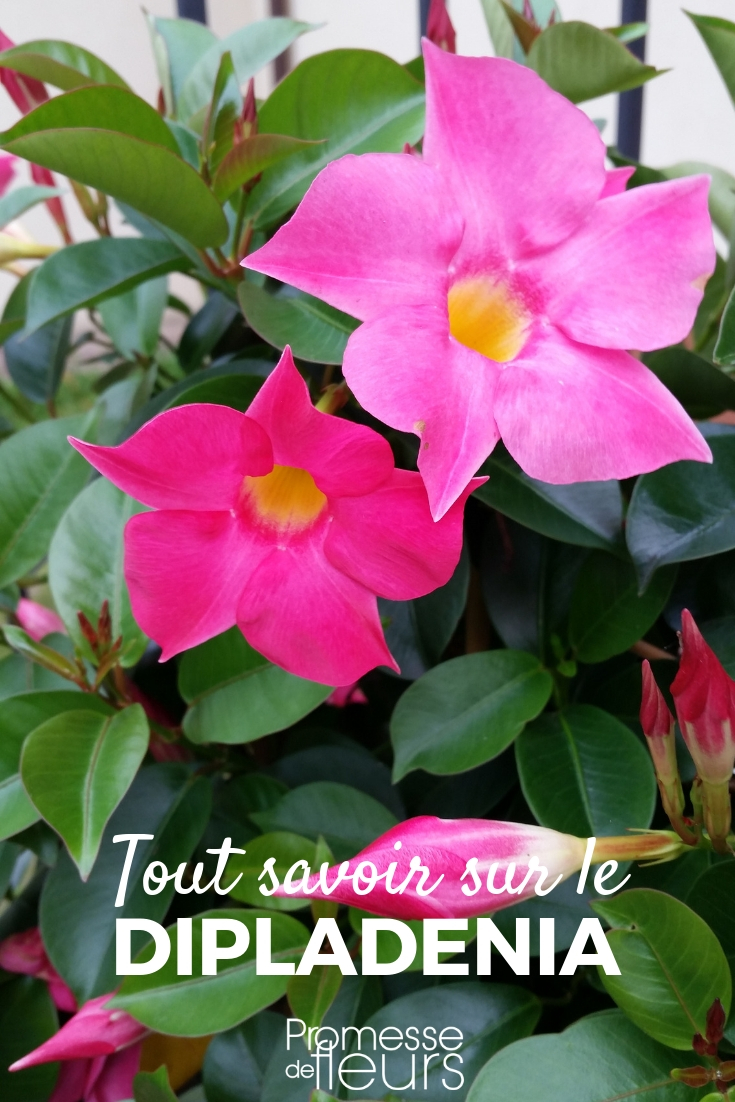































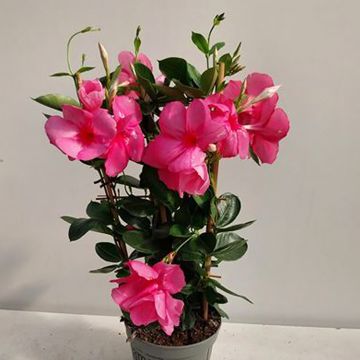


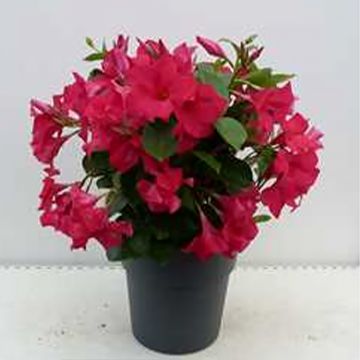

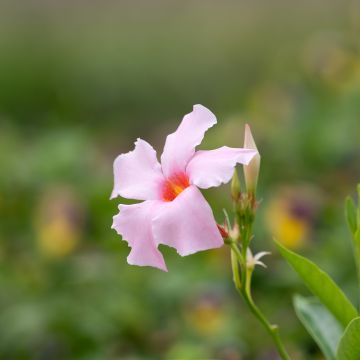
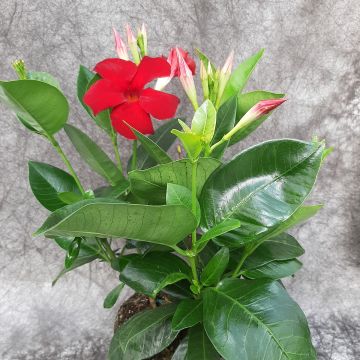
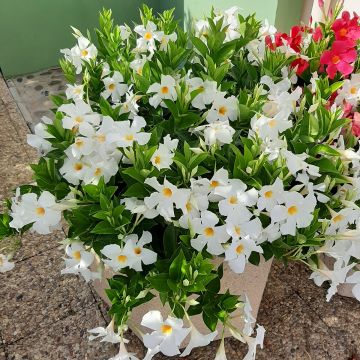
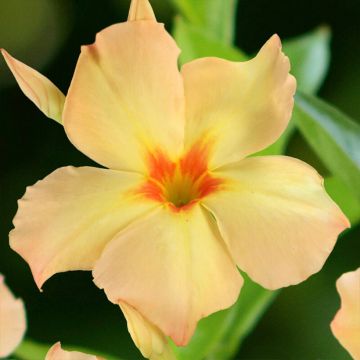
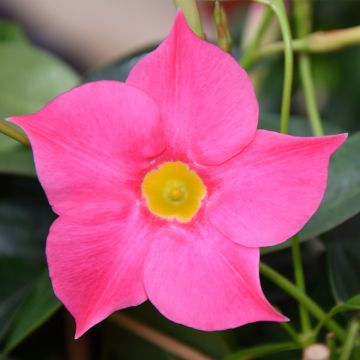
Comments